Summary
- In a world starved of workers and growth, we believe that Asia’s ability to supply both puts the region on a very firm footing over the longer term. Once we get through this current US-led rate tightening cycle and the flush out of weaker financial institutions in the West, we see a bright future for Asia, which is now trading at extremely attractive valuations.
- In March, the MSCI AC Asia ex Japan Index erased all earlier losses triggered by the collapse of several US regional banks to gain 3.5% in US dollar terms as the banking contagion fears eased.
- In North Asia, South Korea (+4.8%), China (+4.5%) and Taiwan (+3.0%) performed strongly, whereas Singapore (+5%), Thailand (+4.4%) and Indonesia (+3.6%) led the gains in the ASEAN region. Elsewhere, returns for the Philippines (+2.4%), Hong Kong (+1.2%), India (+1.2%) and Malaysia (+1.0%) were more modest.
- For China, we retain a positive view on areas of consumption, in particular local brand leaders, and on areas of healthcare, software and select industrials. We hold a favourable view of high-quality banks and companies leveraged to domestic consumption in India and Indonesia. We are, however, selective in South Korea and Taiwan as we await further signs of the tech cycle inflecting.
Market review
Asian markets recoup earlier losses to climb higher
It was a topsy-turvy but rewarding month for Asian stocks, which erased all earlier losses triggered by the collapse of several US regional banks to climb higher in March as the banking contagion fears eased.
The shocking demise of Silicon Valley Bank (SVB), Signature Bank and Silvergate Bank in the first two weeks of March and the downfall of Credit Suisse, which was acquired by UBS on 19 March, rattled global stocks. However, continual reassurance from US regulators that all US bank deposits are safe and the purchase of SVB assets by First Citizens BancShares, a deal coordinated by the Federal Deposit Insurance Corp, calmed nerves and spurred a strong market rally in the latter half of March.
The market turnaround, which drove the MSCI AC Asia ex Japan Index 3.5% higher in US dollar (USD) terms in March, was even more notable, considering that the Federal Reserve and the European Central Bank hiked rates by a 25-basis-points (bps) and 50 bps, respectively, during the month.
Chart 1: 1-year market performance of MSCI AC Asia ex Japan versus Emerging Markets versus All Country World Index

Source: Bloomberg, 31 March 2023. Returns are in USD. Past performance is not necessarily indicative of future performance.
Chart 2: MSCI AC Asia ex Japan versus Emerging Markets versus All Country World Index price-to-earnings
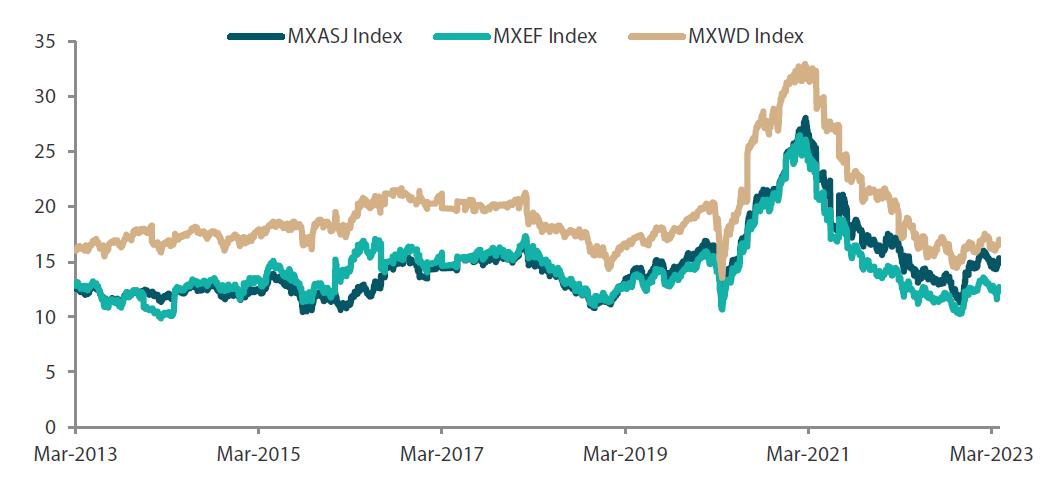
Source: Bloomberg, 31 March 2023. Returns are in USD. Past performance is not necessarily indicative of future performance.
South Korea and China lead the gains in North Asia
In North Asia, China (+4.5%) and Hong Kong (+1.2%) were boosted by a stronger economic growth outlook and a surge in Chinese technology stocks, namely Alibaba and Tencent. The tech-centric markets of South Korea (+4.8%) and Taiwan (+3.0%) also turned in strong gains, supported by a rebound in global tech stocks. Shares of Chinese e-commerce giant Alibaba soared after the company announced plans to split into six corporate units, while Tencent’s shares also jumped after the Chinese internet giant reported stronger-than-expected annual earnings.
During the month, Beijing announced monetary easing measures to support economic growth, with a 25-bps cut in banks’ reserve requirement ratio, while China’s annual consumer price index (CPI) for February rose at the slowest pace in a year. Likewise, the rise in annual inflation rates of Hong Kong, South Korea and Taiwan eased in February compared to the previous month. Still, Taiwan's central bank raised key rates by 12.5 bps in an effort to fight inflation.
All ASEAN markets in positive territory; Singapore and Thailand outperform
In the ASEAN region, all markets posted gains in March as financial sector contagion fears were allayed. Singapore (+5%), Thailand (+4.4%) and Indonesia (+3.6%) led the gains, whereas returns for the Philippines (+2.4%) and Malaysia (+1.0%) were more modest. The rise in the annual inflation rates of Singapore, Thailand and the Philippines eased in February from the previous month; Malaysia’s latest CPI numbers remained unchanged, while Indonesia’s annual inflation for February accelerated slightly from January. During the month, Thailand hiked rates by 25 bps, whereas Indonesia and Malaysia left rates unchanged. In other developments, Thailand dissolved its parliament, paving the way for a general election in May.
Indian equities turn in dreary returns
India registered monthly gains of 1.2%, but investors continued to show caution amid the Adani Group scandal. The rise in the country’s annual CPI slowed slightly to 6.44% in February from 6.52% in January but continued to breach the Reserve Bank of India (RBI)’s target ceiling of 2–6%. This is seen to have heightened the chances of another interest rate hike by the central bank in April.
Chart 3: MSCI AC Asia ex Japan Index1
| For the month ending 31 March 2023 | For the year ending 28 February 2023 | |
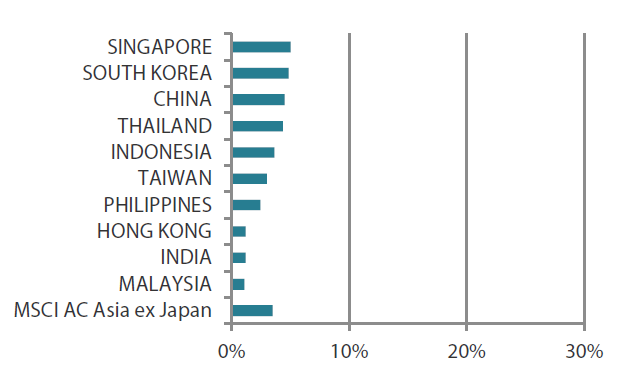
|
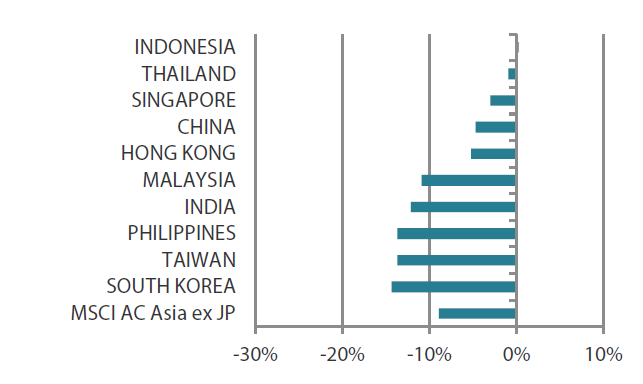
|
Source: Bloomberg, 31 March 2023.
1Note: Equity returns refer to MSCI indices quoted in USD. Returns are based on historical prices. Past performance is not necessarily indicative of future performance.
Market outlook
Significant positive change seen leading to future sustainable returns in Asia
While negative sentiments from the banking turmoil in the West threaten to spill over into Asia, direct exposure of Asia to the vulnerable Western banks is seen to be limited. Smaller scale rate hikes in Asia, prudent supervision by regional financial regulators, outsized capital adequacy ratios and sensible security exposure relative to total assets are considered reasons why Asian banks could be more insulated from the current global banking turmoil. Longer term, in a world starved of workers and growth, Asia’s ability to supply both puts the region on a very firm footing. Once we get through this current US-led rate tightening cycle and the flush out of weaker financial institutions in the West, we see a bright future for the regions. Asia is now trading at extremely attractive valuations, with significant positive change expected to lead to future sustainable returns.
China sets itself apart as a relative safe haven
As China picks itself up from its COVID-19 nightmare and re-opens its economy, in our view the country now sets itself apart as a relative safe haven given its growth premium, financial soundness and policy discipline. On the back of a strong economic recovery in China, we expect a positive feedback loop of job gains leading to income growth and increased consumption. This would booster the initial consumption wave driven by substantial excess savings accumulated during the pandemic. Further, after the annual Two Sessions meetings, policy visibility has improved with a new economics team officially taking over the helm, charged with restoring growth and development. In the medium term, we expect the new Chinese Premier Li Qiang to adopt a policy approach characterised by pro-business pragmaticism. We retain a positive view on areas of consumption, in particular local brand leaders, and on areas of healthcare, software and select industrials.
Asia is much more than just China
While we see many opportunities in China, Asia today is much more than just China. Strong domestic consumption and reform-led structural growth continue to dominate the long-term narrative of India and Indonesia. South Korea and Taiwan today are also amongst the most innovative economies in the world with innovation leadership in the realms of hardware technology and biotechnology.
Structuring reforms boosting the appeal of India and Indonesia
The stars are now seemingly aligned for countries like India and Indonesia due to a confluence of factors. Not only do they have the cheap excess workers needed by the world, but these workers are also more skilled than ever as a result of structural reforms boosting productivity. These reforms also have the effect of loosening bottlenecks on foreign domestic investments inflow, just as geopolitics in the form of “China Plus One”, which is now bringing businesses to their doorsteps. The aforementioned factors continue to drive our favourable view of high-quality banks and companies leveraged to domestic consumption in India and Indonesia.
Staying selective in South Korea and Taiwan
Even though we are constructive on South Korea and Taiwan’s innovation tech leaders, we continue to be selective in the region as we await further signs of the tech cycle inflecting. That said, valuations are a lot more attractive post correction, and some negatives are well discounted in the market. Our focus remains on healthcare contract manufacturers in addition to select hardware technology opportunities.
Chart 4: MSCI AC Asia ex Japan price-to-earnings
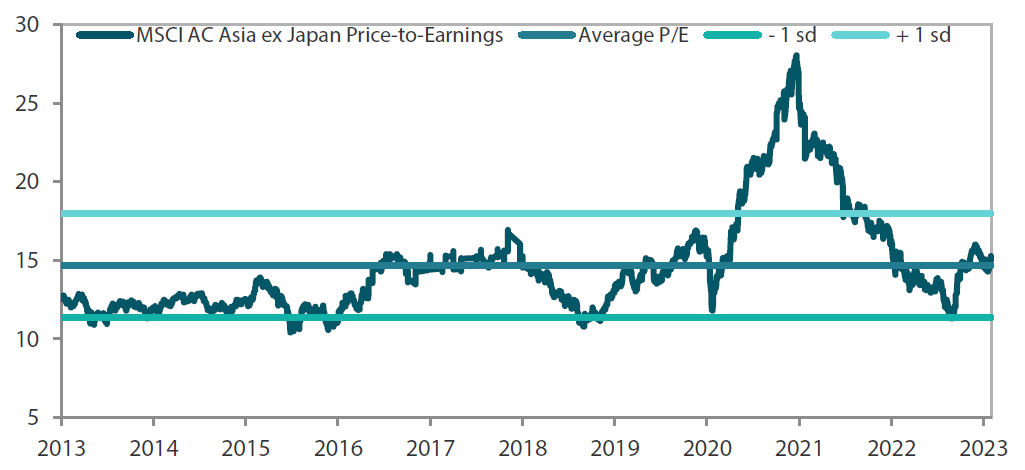
Source: Bloomberg, 31 March 2023. Ratios are computed in USD. The horizontal lines represent the average (the middle line) and one standard deviation on either side of this average for the period shown. Past performance is not necessarily indicative of future performance.
Chart 5: MSCI AC Asia ex Japan price-to-book
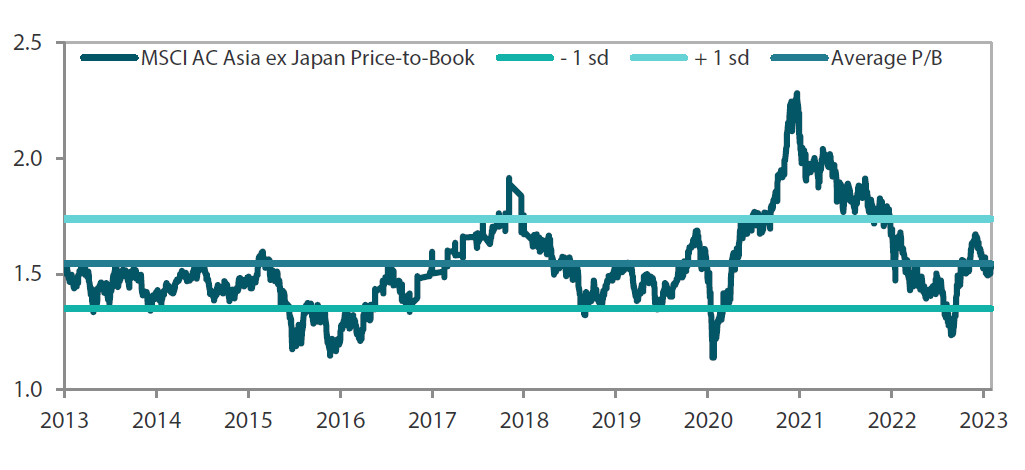
Source: Bloomberg, 31 March 2023. Ratios are computed in USD. The horizontal lines represent the average (the middle line) and one standard deviation on either side of this average for the period shown. Past performance is not necessarily indicative of future performance.




